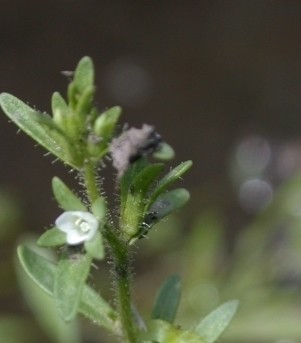Neckweed
(Veronica maximowicziana)

Description
Veronica peregrina is a species of flowering plant in the plantain family known by several common names including neckweed, American speedwell, purslane speedwell and hairy purslane speedwell. It is native to the Americas, and is known on other continents as an introduced species and a common weed. It can be weedy in its native range as well, growing on roadsides, on fields, and in other disturbed habitat. It is an annual herb growing from a taproot. The two subspecies are defined generally on the basis of hairiness: ssp. xalapensis is coated in glandular hairs and ssp. peregrina is a hairless variety. The plant produces erect stems up to about 30 centimeters tall. The leaves vary in shape from linear to lance-shaped to spoon-shaped with smooth or serrated edges; the lower leaves are borne on petioles. The inflorescence is a loose terminal raceme of flowers and lance-shaped bracts. The flowers are generally white and 2 or 3 millimeters wide. Veronica is the largest genus in the flowering plant family Plantaginaceae, with about 500 species; it was formerly classified in the family Scrophulariaceae. Common names include speedwell, bird's eye, and gypsyweed. Taxonomy for this genus is currently being reanalysed, with the genus Hebe and the related Australasian genera Derwentia, Detzneria, Chionohebe, Heliohebe, Leonohebe and Parahebe now included by many botanists. Monophyly of the genus is supported by nuclear ribosomal internal transcribed spacer (ITS) and cpDNA. The taxa of the genus are herbaceous annuals or perennials, and also subshrubs, shrubs or small trees if Hebe is included. Most of the species are from the temperate Northern Hemisphere, though with some species from the Southern Hemisphere; Hebe is mostly from New Zealand. The genus name Veronica used in binomial nomenclature was chosen by Carl Linnaeus based on preexisting common usage of the name veronica in many European languages for plants in this group. Such use in English is attested as early as 1572. The name probably reflects a connection with Saint Veronica, whose Latin name is ultimately derived from Greek, Berenice. Veronica americana is edible and nutritious, as are most species in the genus Veronica, and is reported to have a flavor similar to watercress. Native Americans used Veronica species as an expectorant tea to alleviate bronchial congestion associated with asthma and allergies. The plant can be confused with skullcap and other members of the mint family.
Taxonomic tree:







